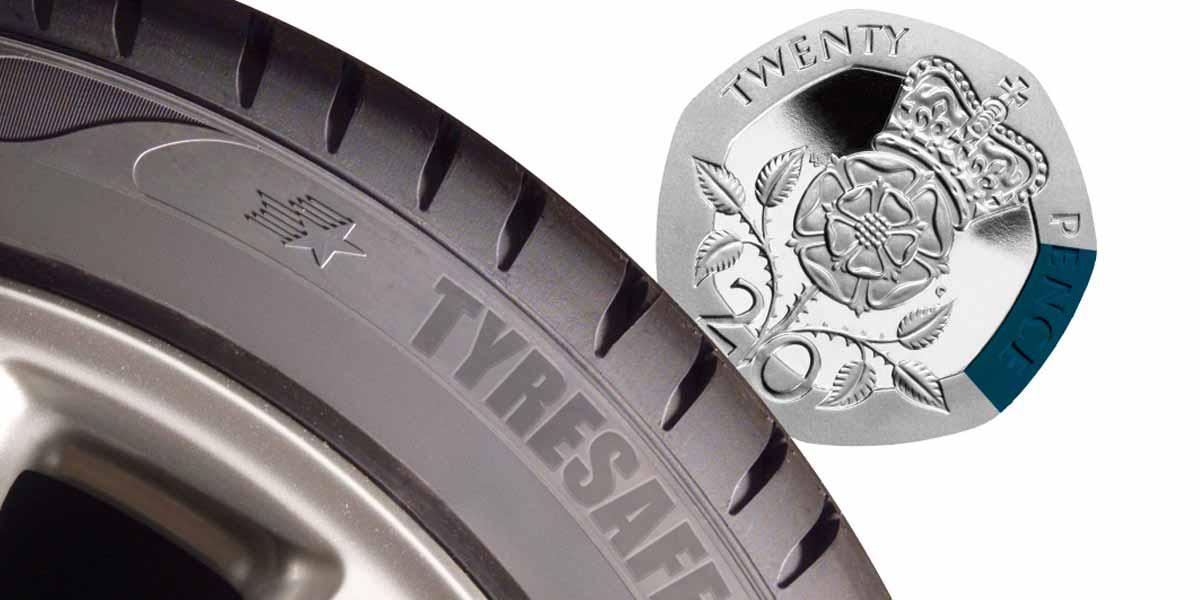Tyres
The legal limit for minimum depth of the tread on your tyres is 1.6 millimetres, across the central ¾ of the tread around the complete circumference of the tyre. For safety reasons it is recommended that you replace your tyres before the legal limit is reached. Many vehicle manufacturers recommend replacing at 3 millimetres. At 1.6 millimetres in wet weather it takes an extra two car lengths (8 metres) to stop at 50 mph than if your tread was 3 millimetres.
A regular check of your tyres can help you to avoid 3 penalty points and £2,500 in fines for having tyres worn beyond the legal minimum limit on your vehicle. It is also a legal requirement to ensure that tyres of different construction types are not fitted to opposite sides of the same axle. The two main tyre types are radial and cross-ply, and these must not be mixed on the same axle.
Mixing brands and patterns of the same construction type is permissible depending on the vehicle type and manufacturers recommendation. Check your vehicle's handbook for tyre fitment details and options.
Looking After Your Tyres
There are many different reasons for tyre wear. Your tyres don't just get worn due to age and use, other factors including emergency braking, incorrect tyre inflation and wheel alignment, and poor road surfacing can easily damage a tyre.
To ensure that you stay safe on the road, it is important that you look after your tyres and check them regularly. We recommend that you inspect your tyres every 2 weeks to check the following:
Maintaining correct tyre pressures
There are three main reasons why maintaining the right tyre pressure is important. The first and most important factor is safety. Tyres that are under inflated can overheat; and over inflated tyres can lead to poor vehicle handling on the road.
The second reason is economy. Over or under inflated tyres have a decreased contact patch with the road and suffer from uneven tread wear as a result. Over inflated tyres will wear more quickly due to the smaller contact patch; therefore, your tyres will need to be replaced more regularly. Vehicles with under-inflated tyres also have increased rolling resistance which means more fuel is required to maintain the same speed.
The third reason for maintaining the correct tyre pressure is the environment. Correct tyre pressures help to maintain optimum fuel efficiency. This can equate to lower CO2 emissions coming from your vehicle than those with incorrect tyre pressures thus reducing the environmental impact of your car.
Vehicle manufacturers will often suggest different tyre pressures for your front and rear tyres so make sure you follow these guidelines. The correct tyre pressures for your car can be found in the vehicle handbook and are often printed either in the sill of the driver’s door or on the inside of the fuel flap.
Checking Your Tread Depth
When braking, your car relies on the tread on your tyres to grip the road and come to a stop in the shortest possible distance. Breaking distance increases as tyre tread wears out so it’s important that you check them regularly to ensure you still have adequate tread on your tyres. It is recommended that tyres are replaced when the tread depth reaches 3mm in order to maintain optimum braking performance.
The legal limit for minimum tread depth in the UK is 1.6mm across the central three quarters of the breadth of the tyre and around the full circumference. Failing to replace your tyres before they reach this minimum limit could result in a hefty fine and penalty points on your licence.
If you place your finger in the main tread groove you should feel a small raised notch. When your tread wears down to the height of this notch, your tyre should be replaced as it has reached the minimum legal tread depth. You can also use a tread depth indicator to gauge the remaining tread on your tyres or even a 20p piece. Place the 20p coin inside the main tread groove of the tyre.
If the outer band of the 20p piece is obscured by the tyre then your tyres have adequate tread. If you can see the outer band of the 20p piece your tyres could be approaching the legal limit so it’s advised to have them checked as soon as possible.
Finally, check your tread depth in at least 3 different locations across the circumference of the tyre to ensure there is no uneven tread wear.


Check for External Damage
Cuts, lumps and bumps are often caused by an impact between the tyre and a kerb, pothole or object in the road. If your tyre has any of these symptoms then you must have the tyre checked as quickly as possible by a tyre specialist, as this sort of damage can result in sudden tyre failure.
It is always recommended to have your tyres checked if the vehicle has been involved in an emergency manoeuvre like sudden and heavy braking. Emergency braking can sometimes leave your tyres with a ‘flat spot’. This can be another reason for premature tyre removal.
